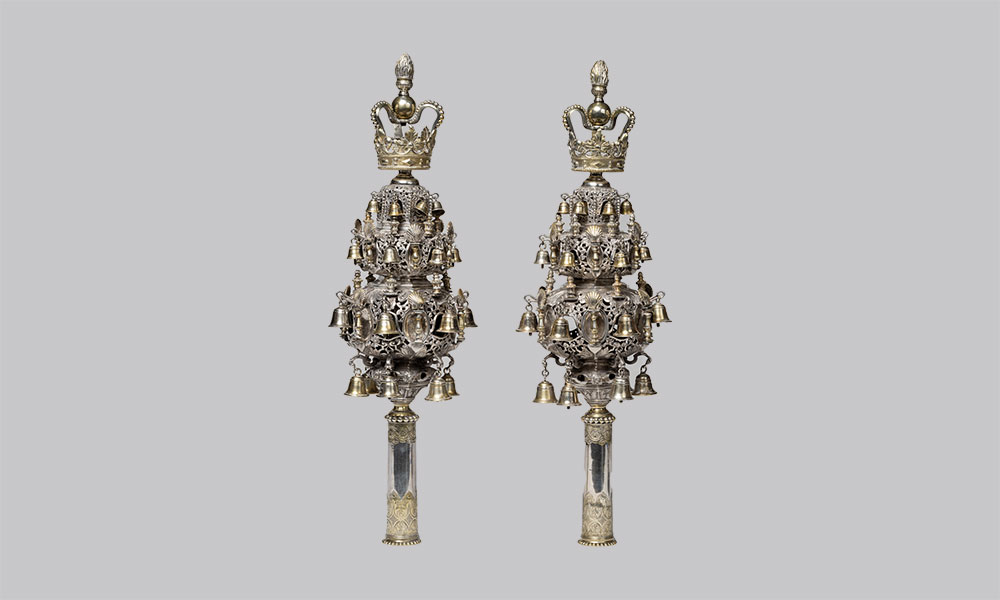Visual Moment | A Sephardi Silversmith’s Masterwork

A remarkable and rare pair of elaborate silver Torah finials have been jointly acquired by New York’s Jewish Museum and the Museum of Fine Arts (MFA), Boston. The finials, which are from 1729, are the work of Abraham Lopes de Oliveyra, the earliest known Jewish silversmith to work in England.
Praised as masterpieces of historical Judaica and noted for their exquisite design, the finials, rimmonim in Hebrew, are designed to sit on top of the two wooden staves of a Torah scroll. Made of partially gilded silver, the finials feature ornate foliate patterns and tiers of bells surrounding three flattened spheres that showcase Oliveyra’s characteristic bold openwork—design made by creating patterns of holes or piercings in the silver. Oliveyra was also known for his use of the shell motif, a characteristic of the era’s nature-inspired Rococo style. The crown at the top of the 19-5/16-inches-tall finials references the royal status Jews traditionally attribute to the Torah. The top of each finial terminates in a pineapple ornament surrounded by a wreath of leaves. The engraved and partially gilded staves are hallmarks of Oliveyra’s work.
“The bells are important,” says Abigail Rapoport, the Jewish Museum’s curator of Judaica, “in that they evoke the ceremonial role of the finials. Their festive sounds announce the presence of the Torah as it is taken out of the ark and carried around the synagogue.” Rapoport first encountered the finials in the course of a research project and felt that they belonged in the museum’s collection. She was taken by their visual coherence and elegance and felt that they were both rich in history and exceptional in artistry. The joint purchase was her idea.

Abraham Lopes de Oliveyra’s story is compelling. He was born in 1657 in Amsterdam to a Jewish Portuguese family who had settled in the Dutch city, known for its atmosphere of tolerance, after fleeing religious persecution. Oliveyra likely studied the art of silver crafting and engraving there and worked as a Hebrew book engraver. A book of psalms he engraved includes a rendering of a silversmith shop. In his early 30s, Oliveyra moved to London. At the time in Western Europe, Jews were prohibited from joining the artists’ guilds, including the silversmiths’ association. Thus most European pieces of Jewish ceremonial art, though commissioned by Jews, were made by Christian silversmiths. In London, however, Jewish artisans had become eligible for membership in professional guilds, so Oliveyra was able to join the silversmiths’ guild. He worked cleaning and repairing silverware in London’s Sephardic synagogue until he received an official certificate to use a designated hallmark (engraved mark) that would enable him to create silverware in his own workshop. He was the only Jewish silversmith in England during this period, and he was frequently commissioned to create ceremonial Judaica by both the Sephardic and Ashkenazi Jewish communities in London.
Among his known works are 11 pairs of Torah finials, a Torah pointer (yad), a hanging Shabbat lamp, and a silver platter that was presented as a gift from the Jewish community to the London mayor at the time, now in the collection of the Israel Museum in Jerusalem. Of those 11 pairs of Torah finials, only one other pair is in the United States—in Manhattan’s Congregation Shearith Israel. Several pairs are in the collection of London’s Jewish Museum.
“We are thrilled to deepen the MFA’s rich holdings of Judaica with Torah finials by such a celebrated Jewish silversmith,” says MFA Director Matthew Teitelbaum. “They are truly magical.” You can see the finials at the Jewish Museum in New York City, where they will be on view through late October. The pair will then go on display at the MFA, Boston starting in December 2023.
